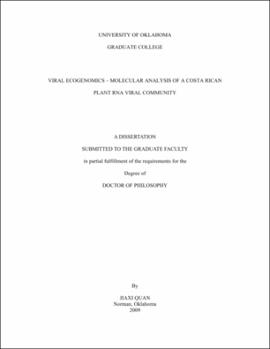| dc.contributor.advisor | Roe, Bruce A. | |
| dc.creator | Quan, Jiaxi | |
| dc.date.accessioned | 2019-04-27T21:24:10Z | |
| dc.date.available | 2019-04-27T21:24:10Z | |
| dc.date.issued | 2009 | |
| dc.identifier | 99160031702042 | |
| dc.identifier.uri | https://hdl.handle.net/11244/318600 | |
| dc.description.abstract | RNA virus metagenome data characterization provides an unbiased picture of RNA viruses in natural environment. To test the hypothesis that plant viral infections are relatively specific for the viral-host interaction and greatly influenced by environmental factors, in my dissertation research, DNA copies of reverse transcribed and amplified virus genomes collected from the Area Conservation Guanacast (ACG) region in Costa Rico that were tagged with one of 24 or 96 short oligonucleotides, were sequenced using a state-of-the-art massively parallel Roche/454 GS-FLX DNA pyrosequencer. Since at least 75 Mb of raw DNA sequence data was collected from each full sequencing run, and because our tagging strategy allowed for multiple samples to be sequenced simultaneously, a data management system was developed to serve as a platform to facilitate efficient and comprehensive analysis of metagenome data collected from RNA virus communities. | |
| dc.description.abstract | After assembly with the Roche/454 Newbler assembler, analysis using BLASTN, BLASTX, and tBLASTX identified 2017 contigs that belong to known or novel virus genomes and 20% of contigs without any significant similarities with current database. A statistics analysis revealed a total of 26 virus families in the ACG region had Partitiviridae as the most abundant plant viral family observed. The most widespread species observed was Zucchini mosaic-like viruses, providing more evidence to the world wide spread of this virus species. The plant host infected with the most number of virus families in the ACG was Alibertia edulis Rubiaceae. | |
| dc.description.abstract | Further analysis revealed the effect of symptom, age, and season on the virus particle concentration on the plant host with symptomatic and old samples having a statistically higher number of virus particles when compared to asymptomatic and young plant samples. Plants collected during the Costa Rican rainy season had a higher concentration of viral infection than did those collected during the dry season. The two largest sequenced contigs, both of which are over 11,000 nucleotides, were characterized and predicted to be the putative novel members of the endornavirus family. | |
| dc.description.abstract | Overall these studies confirmed my original hypothesis that viruses in ACG are diverse, with large numbers of new, previously unknown plant viruses present in the environmentally diverse ACG. These studies also confirmed that widespread and multiple viral infections are common phenomena among these viruses and that plant age and the relative amount of available moisture can be directly correlated with higher viral titers on plant hosts. | |
| dc.format.extent | 136 pages | |
| dc.format.medium | application.pdf | |
| dc.language | en_US | |
| dc.relation.requires | Adobe Acrobat Reader | |
| dc.subject | Viral genetics | |
| dc.subject | Genomics | |
| dc.subject | Viral genomes | |
| dc.subject | Plants--Viruses--Costa Rica--Area de Conservación Guanacaste | |
| dc.title | VIRAL ECOGENOMICS - MOLECULAR ANALYSIS OF A COSTA RICAN PLANT RNA VIRAL COMMUNITY | |
| dc.type | text | |
| dc.type | document | |
| dc.thesis.degree | Ph.D. | |
| ou.group | College of Engineering::School of Chemical, Biological and Materials Engineering | |
